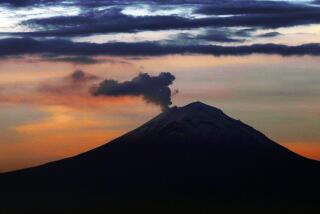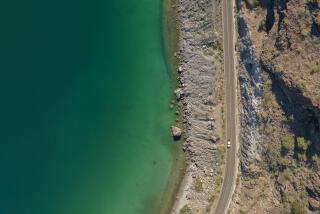HOT SPOT
- Share via
LA FORTUNA, Costa Rica — It was an eruption in its own right, a violent displacement of water, the flared gills of a savage predator, a whooshing gulp and a blur of purple and black.
And while the towering volcano looming so ominously in the distance was merely smoking, the fish that so suddenly shattered the calm of the cove was smoking!
It dashed out of sight as quickly as it had appeared, taking with it a shiny white lure attached to a line on a reel being cranked by an angler who made a mental note, during the next several minutes of chaos, that this was a fish from hell if ever there was one.
Not far beneath the surface, after all, was a network of tumultuous chambers churning with fire and prone to outbursts so spectacular that they attract tourists from all over the world.
For fishermen, there’s an added attraction: a high-spirited little game fish called guapote (wa-POH-tay), incredibly big on both fight and bite, with long, piercing teeth and a temperament much like that of the volcano.
Indeed, for those venturing onto Lake Arenal, in the shadow of its namesake volcano, the term “hot bite” sometimes applies even when the fish aren’t biting.
Rumbling, hissing, billowing plumes of steam and falling ash are often part of the experience, made complete only when a great guapote charges up and clamps down on your lure, giving you all the heat you can handle.
Deadly Eruption
This small agricultural community in north-central Costa Rica is wonderfully scenic and quiet most of the time, blanketed with green pastures and surrounded by lush forests.
But, because its most prominent landmark is this country’s most active volcano, it never stays that way for long.
Arenal announced its presence like a bombshell in 1968, literally blowing its top and showering on an unsuspecting populace boulders and ash, releasing rivers of lava that cut swaths of destruction.
Two villages were destroyed and 78 people killed during three days of intense activity that darkened the sky with ash and sent giant rocks crashing to earth as far as a mile away.
Before the fateful blast, Arenal was considered by most to be merely another mountain, cone-shaped but heavily forested and certainly posing no threat.
In the years since, the menacing volcano--now easily discernible as such, with largely barren slopes and an ever-present halo of steam--has maintained its presence with frequent reminders of its volatility, some mere tremors but others full-scale eruptions.
Without doubt, most of the dozen or so small resorts in and around La Fortuna would not exist without the volcano and, ironically, someday might not exist because of it.
Only last year the region was evacuated in anticipation of a major eruption, which occurred on cue, shaking things up and pouring lava dangerously close to the area’s most popular hotel.
Fortunately, scientists now keep a close eye on Arenal and are able to gauge its disposition with remarkable accuracy. However, given the whims of Mother Nature, there are no guarantees.
Birth of a Fishery
There’s no doubt, among scientists anyway, that the eruption of Arenal in 1968 was the most significant event to have occurred in this region in recent history. Radiocarbon dating shows that the volcano had not previously erupted since the mid-1700s.
But for windsurfers and fishermen, it was an event 10 years later, in 1978, that gave them reason to make the two-hour trek from the Costa Rican capital of San Jose: the completion of a dam and hydro-electric power plant.
When the dam went up, a vast wetlands became a sprawling reservoir, 20 miles long with more than 40 miles of shoreline.
Strong northerly winds prevalent at its northern end from November through April attracted board-sailors who started making annual pilgrimages here, and continue to enjoy ideal sailing conditions with the 5,000-foot volcano as a backdrop.
At the more protected southern end, only about five miles from the summit of the volcano, Arenal’s many coves became a haven for fishermen. A country famous for its saltwater fishing on both coasts suddenly had a big lake teeming with small game. The influx of several species of fish from feeder streams--and the added “carrying capacity” for those already residing in what had been mostly large swamps--enabled fast and steady growth.
Guapote, at the apex of the food chain, took full advantage of their expansive new domain, staking out territory along the weed- and rock-strewn shores and becoming masters of ambush.
“On my first morning of fly-fishing on Lake Arenal, I was able to hook and release 25 guapote in sizes between seven and nine pounds,” says Peter Gorinsky, a renowned guide and one of Arenal’s pioneer anglers. “And, yes, many times we have had to move to other fishing areas on the lake to escape heavy ash fall and [subsequent] acid burns.”
Practically everyone who visited Arenal in its early days met with similar success and, while guapote reside in smaller lakes and streams throughout most of Central America, the creation of an actual guapote fishery at Arenal gave the fish a much greater following.
Jerry Ruhlow, a long-ago transplant from Los Angeles, and a few of his friends started organizing guapote tournaments. Ruhlow, who publishes Costa Rica Outdoors magazine and runs a travel business under the same name, is also credited with giving guapote a simpler name--rainbow bass.
He did this “over some good tequila” in the Blue Marlin bar at the Del Rey Hotel in San Jose. “I thought, ‘Geez, we have such a great fish here but nobody can remember its name,’ ” Ruhlow recalls. “It’s kind of like a bass, it has kind of a rainbow hue, so I said, ‘Let’s call it a rainbow bass.’ ”
Technically, guapote are in the cichlid family, as are their even more ferocious cousins, peacock bass, a highly prized game fish in South America. Like peacock bass, guapote have longer and more pronounced fin structures that run almost the length of their bodies, which give them incredible power and torque.
“He has the poor largemouth bass beat all to hell,” says Doug Kralik, a former U.S. bass pro who moved to Costa Rica 10 years ago to manage the Rawlings baseball factory in Turrialba in east-central Costa Rica.
Without an actual bass lake to satisfy his passion, Kralik quickly turned his attention to Arenal, and with perhaps the only high-speed bass boat in Costa Rica, he makes the cross-country journey from Turrialba to La Fortuna as often as he can.
The all-tackle world record for guapote is a 12-pound 9-ounce specimen pulled out of little Lago Hule, a practically inaccessible fishery about 50 miles from La Fortuna, situated inside the rain forest-lined crater of an extinct volcano.
Hule was a favorite haunt of a small group of hardy guapote aficionados until the lake was recently ruled off-limits by the Costa Rican government, thereby turning Arenal into the favorite to produce the next record.
And if one man is favored to land that prized guapote, it probably is Kralik, who has come close with two topping 10 pounds, six or seven at about nine pounds and dozens between five and eight pounds, all of them considered trophy-sized.
One that got away on a recent trip might have put Kralik in the record book. “That guapote pulled me right out into the middle of the lake by the dam,” he recalls. “I’m just sitting there holding on for 10 or 12 minutes and he’s just pulling me. I thought something has to give, so I started pulling back and I couldn’t move this fish at all. That was a big ol’ guapote. I don’t know how big, but big enough to pull the boat.”
Hookup!
It’s dawn in La Fortuna and coal-colored clouds are racing across an otherwise inviting blue sky. The summit of the volcano is in full view, a rarity, puffing away as if to show the world that it’s still worth paying attention to.
Kralik and Ruhlow, longtime friends and occasional fishing partners, arrived a day earlier and are on the lake shortly after a breakfast of eggs and gallo pinto, a Costa Rican staple that is basically a tasty mixture of rice, beans, garlic and onion.
The two spend most of the day slowly working the coves and shoreline, casting spinnerbaits and crankbaits with little success. Fishing for guapote is no longer what it was, thanks mostly to poachers and local anglers who have no concept of catch-and-release. Guapote are considered a delicacy and, although there is no commercial market for them, well-connected locals get them at some restaurants by request.
Pressure on the fishery over the years, Kralik says, has made the bigger fish more wary and harder to come by. Thus, he adds, catching one is much more satisfying. Ruhlow agrees, saying he has been trying to catch a “mountable” fish of seven pounds or more since the lake was created, to no avail.
A few small fish are caught, and a few larger ones are spotted chasing lures, but nothing of note is landed after several hours of probing cove after cove, point after point, despite the constant change in tackle and tactics by Kralik, who can adeptly place a cast in the tightest of openings.
A reporter, along for the ride and given a fancy bass rod to try his luck, is casting along with these two characters, waiting for something to happen while enjoying a view of vast green meadows, the singing of tropical birds, the smell of Kralik’s freshly lit Cuban cigar.
The equipment is also worth appreciating. The line Kralik uses is not your typical bass-fishing monofilament, but 30-pound SpiderWire, thinner but stronger and unyielding, necessary, he says, to keep the bigger fish from reaching their structure-lined hideouts.
Even his lures are customized, with sturdier hooks strategically placed to ensure solid hookups.
They might as well have no hooks, the reporter surmised as the day grew longer. The volcano was no longer visible and the sky darkened under heavy cloud cover. An eerie calm settled over the region, and even die-hards Kralik and Ruhlow were ready to call it quits, when all of a sudden the lake opened up violently only a few feet from the boat.
The rod bent double and the reporter, of all people, found himself muttering a few choice words while trying to figure out how to handle such an explosive situation.
A huge guapote had dashed out of the reeds and set savagely on his spinnerbait, and was speeding back toward the shoreline. “Reel, reel . . . don’t let him get back in there,” Kralik shouted. “I am reeling, what . . . do you think I’m doing,” the intrepid angler responded.
The strength of the fish in relation to its size was incredible; it practically turned Kralik’s boat around during the initial run. It managed to reach a bundle of well-rooted reeds, but the reeds soon broke free of the mud and the battle raged anew.
Kralik turned the fight in the angler’s favor by carefully maneuvering the boat to keep a good angle on the fish. Finally, it tired and was scooped up in Kralik’s net.
On his portable scale it weighed in at 7 pounds 1 ounce, causing Ruhlow to quip that a first-timer has no business catching the fish he has been pursuing for 20 years. No problem, the angler said, releasing the monster so he could try for it another day.
The day was complete now, the fishermen agreed as Kralik started the motor and headed for the ramp. Not quite, the reporter noted. The country’s most active volcano hadn’t really done anything yet.
More to Read
Sign up for Essential California
The most important California stories and recommendations in your inbox every morning.
You may occasionally receive promotional content from the Los Angeles Times.










